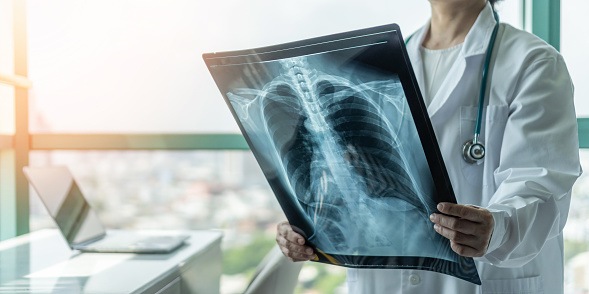For patients with asthma, treatment with PT027, fixed-dose combination of budesonide and albuterol in a single pressurized metered dose inhaler (pMDI) more effectively prevented exercise-induced bronchoconstriction (EIB) compared with placebo pMDI. Craig Laforce, MD, from North Carolina Clinical Research, presented these findings at the 2021 American Thoracic Society International Conference.
PT027 is currently in clinical development as an anti-inflammatory rescue/reliever for asthma. Dr. Laforce shared results from the randomized, double-blind, single-dose, crossover TYREE study, which assessed the preventative effects of PT027 (2 puffs 80/90µg MDI) compared with placebo pMDI (2 puffs) on EIB in patients with asthma.
The trial enrolled 60 adults and adolescents (≥12 years) with asthma and EIB receiving short-acting beta2-agonists (SABAs) on an as-needed basis alone or in addition to low- to medium-dose inhaled corticosteroid maintenance therapy. Per trial protocol, EIB was defined as a ≥20% decrease from 5-minute pre-exercise challenge test (ECT) best forced expiratory volume in 1 second (FEV1) observed within 60 minutes after ECT.
TYREE’s primary endpoint was the maximum percentage fall from post-dose, pre-exercise baseline FEV1 observed up to 60 minutes post-ECT. Secondary and exploratory endpoints included percentage of subjects with a maximum percentage post-ECT fall in FEV1 of <10% (full protection) and <20% (partial protection).
At screening, the mean percent predicted FEV1 5-minute pre-ECT was 83%. The study met its primary endpoint, defined as the maximum percentage fall from post-dose, pre-exercise baseline FEV1 observed up to 60 minutes post-ECT. Mean maximum percentage falls in FEV1 from baseline in FEV1 were 5.45% with PT027 and 18.97% for placebo, respectively, for a difference of –13.52% (P<0.001).
The proportion of participants who were fully or partially protected from EIB were 78.3% and 28.3%, respectively, with PT027 and 90.0% and 51.7%, respectively, with placebo.
Similar results were also seen in subgroup analyses of subjects receiving SABA as needed with or without maintenance inhaled corticosteroids.
Adding that PT027 was well tolerated, the study authors concluded that “the TYREE study demonstrated efficacy of PT027 to prevent EIB in subjects with asthma … when compared to placebo. These results provide important information towards the evaluation of PT027 as a potential new anti-inflammatory rescue/reliever therapy for subjects with asthma.”







 © 2025 Mashup Media, LLC, a Formedics Property. All Rights Reserved.
© 2025 Mashup Media, LLC, a Formedics Property. All Rights Reserved.